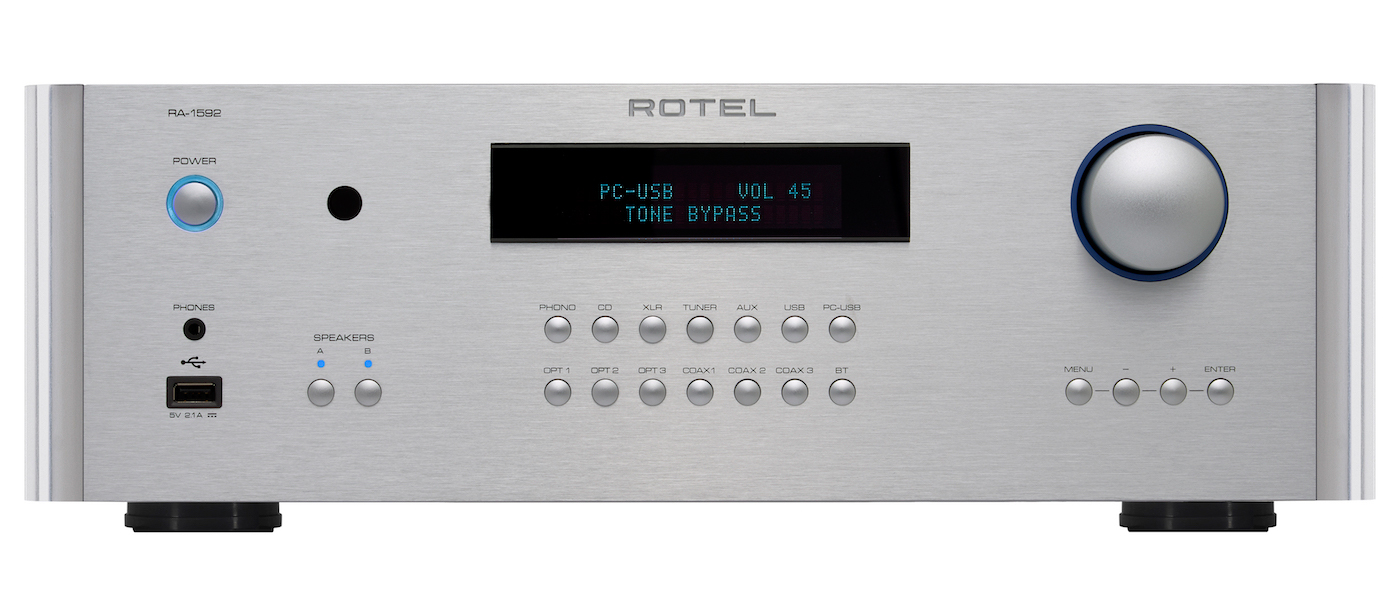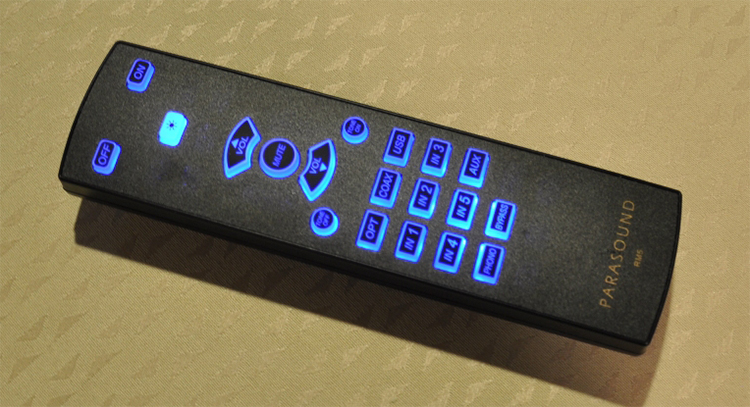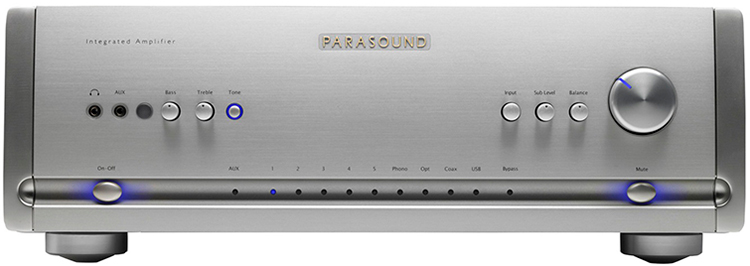
A complete audio manager, the Halo Integrated offers analog and digital inputs and a robust amplifier section.
Parasound Halo 2.1 Channel Integrated Amplifier
- Excellent DAC section with three digital inputs
- Balanced XLR input and output, including one for a subwoofer
- Phono stage for both MM and MC cartridges
- Sophisticated bass management
- John Curl circuit topology amplifier design
- Theater Bypass
Back in 2014, I concluded in my review of the Parasound Halo P-5 preamplifier saying that it was simply a bargain because it included in addition to the preamplifier, a DAC, bass-management, a phono stage and headphone jack. The only thing possibly missing was amplification. Well now that’s been done! And it wasn’t much of a stretch to add as Parasound makes some great power amplifiers, we just needed Richard Schram, President and Founder, to build it. Is the Halo Integrated simply a P-5 with an amplifier!? Well, yes, sort of…but it’s not surprising that Parasound made it more.
Power Output – Both channels driven (from Manufacturer):
0.05% THD – 160 watts x 2 @ 8 Ω or 240 watts x 2 @ 4 Ω
0.9% THD – 180 watts x 2 @ 8 Ω or 270 watts x 2 @ 4 Ω
Total Harmonic Distortion (THD) (from Manufacturer):
< 0.01 %, average listening levels
Phono Stage Sensitivity / Input Impedance:
MM: 35 dB / 47 k Ω
MC: 52 dB / 47 k Ω or 100 Ω
Supported DAC Sampling Rates:
USB: up to 384 kHz / 32-bit PCM
DSD Native: DSD 64, DSD 128, DSD 256
DSD over PCM (DoP) at 384 kHz
Coax/Opt: up to 192 kHz / 24-bit PCM
Digital to Analog Converter:
ESS Sabre32 Reference ES9018K2M
384 kHz / 32-bit
Headphone Amplifier:
Texas Instruments TPA6120A
Output Impedance 10 ohms
Dimensions:
Width: 17-1/4″ (437 mm)
Depth: 16-1/4″ (413 mm)
Depth, with cables 17-1/4″ (437 mm)
Height, with feet: 5-7/8″ (150 mm)
Height, without feet: 5-1/4″ (133 mm), 3U
Net Weight:
33 lb. (15 kg)
MSRP:
$2,495.00
Company:
SECRETS Tags:
Parasound, Integrated, DAC, Bass management, Theater bypass, phono stage, Integrated Amplifier Reviews 2016
The Integrated hasn’t varied much styling-wise from the current Halo line. The description of the Integrated can read like any other Halo product; slightly sloped brushed aluminum faceplate and softer rounded ends. The edges are still glossy grey plastic matching the brushed aluminum. What is most noticeable is the etched logo which differs from the typical Halo product that is silk screened. The illusion is the face-plate has more depth or heft. I assume this will be the new format for the logo moving forward on Halo products.
Adding the amplification I’d expect the case to be larger and naturally heavier than the P-5 and so the Integrated stands a shade less than 6” and weighs 33 pounds receiving most of its heft from an oversized toroid power transformer with 40,000 µF filter capacity.
In keeping with the audiophile “look” there is no visible display of any kind and the Halo Integrated front is arranged simply and cleanly. Parasound makes use of LED backlighting to emphasize selector buttons. The glowing buttons are the power on/off and the mute, both switching from blue to red when activated. The smaller tone control also glows when active. Most importantly as I discovered the volume control also glows with a clock-hand stripe indicating the volume level. I do listen to music mostly in the evenings and generally in darker rooms, having the volume visible made my life a lot easier.
But the layout is straightforward input selection is indicated along the bottom, a large volume control on the upper right and smaller buttons for balance and sub level. Additionally there are two front face jacks, one for headphones and the other for auxiliary use. The Aux input is given a 12 dB gain matching volume levels of other sources.
The rear layout again is classically Halo; inputs include RCA, line-level analog for up to five devices, a sixth MC or MM phono input with selectable cartridge gain and not least a balanced XLR input.

A 384kHz ESS® Sabre32 Reference DAC handles the three digital inputs and include; asynchronous USB 2.0 supporting PCM up to 384 kHz/32-bit, native DSD 256 and also DoP DSD streams and the coaxial and optical inputs support PCM up to 192 kHz/24-bit.
Balanced outputs for both channels also include a third XLR output for a subwoofer. Speaking of bass…
The Halo Integrated “2.1” identifies analog bass management for your subwoofer. By switching off the crossover on your subwoofer, both low and high pass crossover settings on the Integrated can be set from 20-140 Hz. Final volume adjustments can then be made on the front panel. You can also deactivate the Parasound crossover and send a full frequency signal for the subwoofer to handle the crossover settings.
Like all Parasound Halo preamplifiers, the Integrated allows for a theater bypass if the unit is placed in a system beyond two-channels. This feature allows you to use the Halo Integrated for the front two speakers while letting your processor/receiver handle the remaining channels. Additionally, the Integrated can be controlled with IR inputs from third party sources. The Halo also includes a 12-volt trigger for on/off options including an amplifier fitted with a 12v input.
The Integrated shares with all the Halo amplifiers a Class A/AB, J-FET input stage and MOSFET driver stage. Integrating the amplifier with the pre-amp sections, Parasound made great efforts to isolate the power supply, intended to remove cross contamination. 160 WPC driving 8 Ω speakers is the least you will achieve. I can tell you it’s more than plenty but if you insist on using the Integrated as a preamp only, Halo provides a pre-amp output with crossover settings.
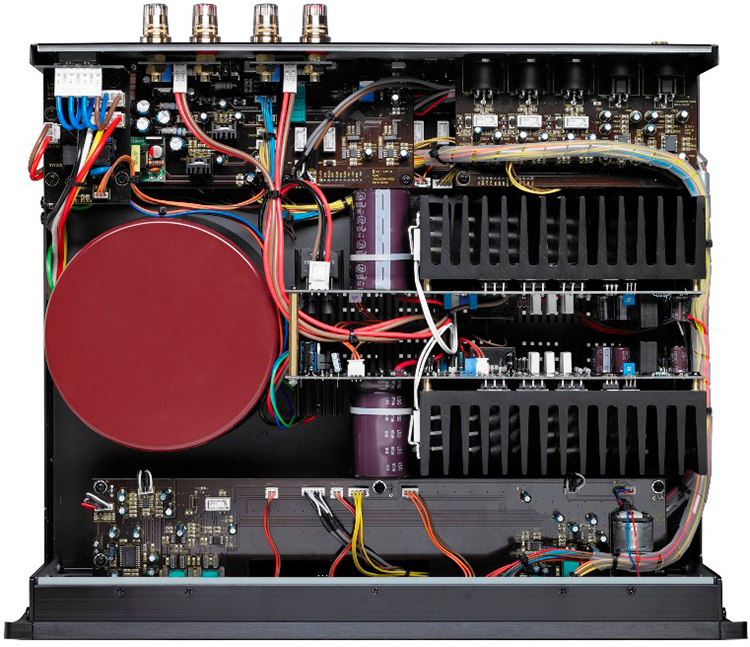
A word about the Halo manual, it’s very well done and not only gives instructions but also good advice, just like Richard Schram would do.
The remote control is the best I’ve seen from Parasound. It provides complete control with a built-in backlight feature along with volume, mute and all input selections. Additionally, although it does allow you to activate the tone control, the actual adjustments are made manually on the front panel.
The beauty of this integrated amplifier is truly the single-source management – bringing together every possible input I have. The turntable I use is the Marantz TT 15S1. Additionally I fed the Halo Integrated an analog input from a Meridian Explorer 2 DAC using my MacBook Pro and Audirvana Plus software playing MQA material. I’m in the process of auditioning the newer version of the Meridian Explorer DAC previously reviewed. I also fed high-resolution audio material direct from my MacBook to listen to the Halo internal DAC and used a Marantz SA 15S2 SACD player as a transport letting the Halo do the digital processing.
For speakers I used PSB full-range Imagine X1T and their SubSeries 200 subwoofer. I did spend a fair amount of time with the subwoofer crossover settings on the rear getting what I thought was just the right balance. I took my time trying both the crossover options on the Integrated as well as defeating it and letting the sub control the crossover settings. In the end I enjoyed using the Parasound bass management because it allowed me to make some final adjustments on the front panel.
All cables used were from Transparent Audio, speaker, interconnects, USB and power.
Anyone familiar with Parasound’s Halo “sound” will know how neutral their amplifiers and pre-amps are, leaving no signature of their own, whatsoever. This was consistent, of course, with the Halo Integrated. The least concern I had was the power output, I rarely turned the volume dial much past 10 o’clock where the dynamics reached a pinnacle volume with no distortion or clipping. Likewise, low volume playback didn’t degrade the sound or leave it flat. I would also say that this contributes to a very flat frequency response, across the board.
I managed to break-in the Halo Integrated feeding it a digital signal from my cable box until I was able to install in my two-channel system. The Halo Integrated did run a bit warm although I wasn’t overly concerned about it. What also struck me was how quiet the Halo amplifier is. Other than a bit of feedback from my turntable there was virtually no hum or hiss from my speakers.
In my experience, Parasound Halo amplifiers always offer a spacious and open soundstage with excellent imaging from vocals and instruments. Bass as adjusted is simply pleasurable – palpable, convincing, deep and tight.
Using my CD player as a transport, I ran a digital signal to the Integrated via Toslink. Bruce Cockburn’s Speechless Instrumental guitar-centric music was impressively rich and textured with an abundance of depth and dimension. The low bass strings had enough weight while the upper notes were airy and clean.
Cantus, While you Were Alive CD is beautiful choral music, a bit eclectic yet offers a wonderful spacious sound. The Halo Integrated renders the nine male voices with depth and character. Powerful and gentle, their voices are articulated, sensing the deep bass and baritones to the high countertenors in the group.
The Beatle’s White Album on vinyl offers not only the voices of the Beatles but some wonderful orchestration as well. The Halo played several tracks to a level I truly never appreciated before; instruments especially were well defined articulate while there was significant clean bass impact. In fact it made me make the slightest adjustment to the front bass control.
The Halo also impressed me giving the Miles Davis’ 1956 album, Relaxin’ With The Miles Davis Quintet studio recorded album a club “feel”. Melodic, with excellent instrumental tone and spatiality, Miles’ trumpet always front and center sounded clean, articulate and brassy. The piano was sufficiently mellow and warm while standup bass was rich and full.
The Halo doesn’t shy away from some extra volume as I cranked some digital high-resolution music via my laptop, listening for that “cold” digital sound. What I got in truth from the Halo was a new appreciation and respect for high-resolution audio because it sounded much richer and more textural than I’ve heard in the past, at least in my system. For lack of a better word, there is truthfulness to the sound of the Halo Integrated. I downloaded several pieces of music from HD Tracks, none give me more goose bumps than the 2L MAGNIFICAT track 4: Et misericordia at 352 kHz/24 bit playback. The Halo handled the Nidarosdomens jentekor girl’s choir with such finesse and warmth I’m left in awe.
Additionally impressive from the 2L orchestral music Astrognosia & Aesop also in 352 kHz/24 bit playback, the thwack of the bass drums, the delicate flutes and brass instruments are superb through the Halo Integrated.
Although MQA is the most exciting format going at this time, I am only able to feed MQA material through the Meridian Explorer 2 via a line level input thereby bypassing the DAC in the Halo. Still no less satisfying, the Halo handled the analog input gracefully. DSD64 tracks like Mozart’s Violin Concerto in D major KV 218 or Haydn String Quartet in D, op. 76, No. 5 both offer rich renditions of the string instrument, with proper timbre, speed and authority.
Worthy to note, running the high-res audio through a Mac doesn’t require the setup required for a PC. Windows users will be asked to download drivers.
Lastly I do apologize for not spending time with the headphone section of the Integrated, perhaps if there is enough time before I return the Halo Integrated I will have spent some quality time listening and augment this review in the future.
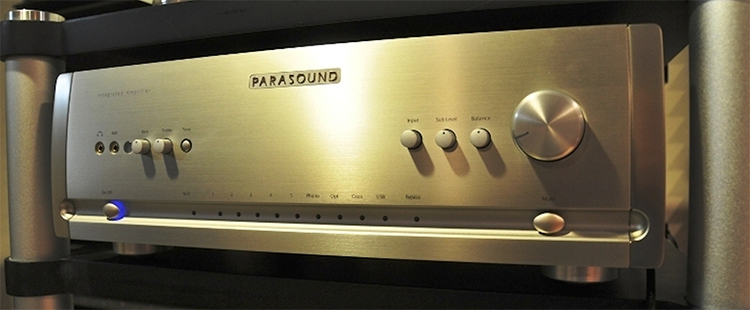
Don’t Waste Your Time Trying to Compare What THE PARASOUND HALO Can Offer With Another Audio Product With the Features and Ability of this Integrated at the Price Parasound Sells it for.
- Excellent dynamics and power
- DAC is excellent
- Bass Management
- Neutral Sound
- A flaw for me to identify
Am I biased towards Parasound Halo products? Yes, unquestionably, proudly. I own several pieces. Halo gear is reliable, well made and superbly engineered and can’t be beat for value. You’d be hard-pressed to find anyone who doesn’t like the Halo Integrated – the sound, the features, and the pedigree. With an excellent DAC and an amplifier that has enough punch to handle any dynamics one would want. I’m scratching my head wondering what’s lacking.
This integrated will make you reconsider the need for separates, honestly. I’m thrilled to compare my Parasound P-5 Preamp/ A-21 Amplifier combination with the Halo Integrated; it really is that good and an early favorite to receive“Best of” honors in the category.


